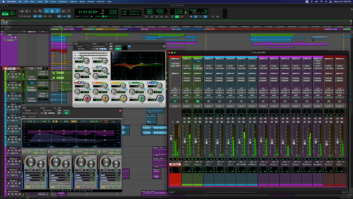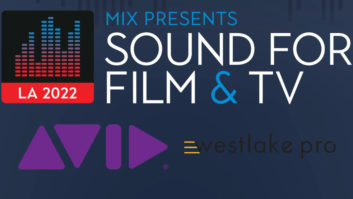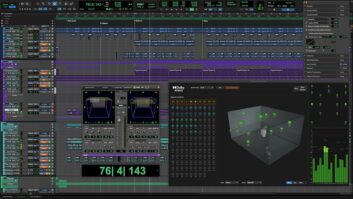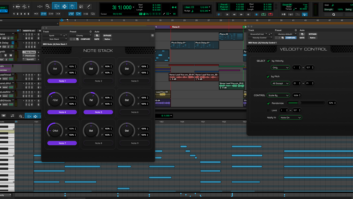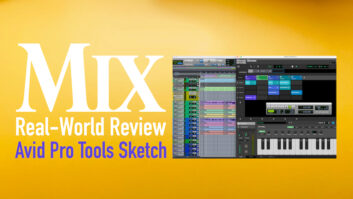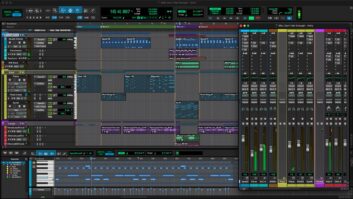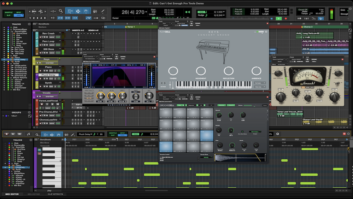Updating software — two simple words that often convey visions of frustration, difficulty, anger and, of course, change. But that same change is part of the fast-moving world of technology we live in. And, more often than not, it’s for the better. So yes, it was with some trepidation I proceeded to update my entire system to Pro Tools 9, Avid’s latest version for the majority of our DAWs. Here is my experience with the process and its results.
What Pro Tools Means To Me
Pro Tools has been, and continues to be, the pulse of my daily workflow. I have three different Mac computers that run it: a MacBook Pro and a Mac Pro (both running Pro Tools LE 8.0) and an older but super-stable G5 (which ran Pro Tools HD 7.4 with a Digidesign 192 I/O). Using PT, session types range from composition, scoring and sound design to picture for television, basic music recording, and all the way up to 70-plus channel 5.1 mixes. In addition, I run programs such as Propellerhead Reason, Ableton Live, Apple Logic Pro, Bias Peak, and so on.
Historically, Pro Tools LE sessions wouldn’t seamlessly “talk” to HD sessions and vice versa. Due to the lack of delay compensation and OMF/AAF file interchange, I would be forced to mix on the HD rig, which meant the inevitable printing of certain tracks and dreading of the whole interchange process. Also, I had a Universal Audio UAD card in the LE system, but not on the HD rig; any UA plug-ins I used required printing before the final mix. As a whole, I must admit it was a frustrating and somewhat inefficient way to work.
After reading up on Pro Tools 9, it seemed I could finally have all three systems running in harmony. But then I faced the prospect of actually doing it.
Installation 1: MacBook Pro
I received the boxed version of Pro Tools 9 and went right to work. With the included iLok, there was no need to download any authorizations, only to register the software for future upgrades, etc. Inserting the installation disc into my laptop, I was abruptly informed I needed to update my Operating System to at least Snow Leopard Mac OS X 10.6.2 — damn, hurdle number one. So after digging out a Snow Leopard disc, I went through the process and then ran Software Update to get to the current 10.6.5.
From there, Pro Tools 9 installation took literally just a few minutes. “Wow, that was pretty easy,” I said to myself.
According to Avid, I can now run Pro Tools 9 using Core Audio. Great! So, I launched an 8.0 session, and it opened right up in 9.0. Checking out the Current Engine in the new Playback Engine menu (Setup > Playback Engine), it displayed something called Pro Tools Aggregate I/O. I then pressed play and — oh, joy! — I heard the audio through the MacBook Pro speakers. I immediately rejoiced in the fact that I’ve been using Pro Tools since its debut, and now, all these years later, I can run it without hardware. I was also able to record directly into PT9 using the built-in computer mic, which is great for scratch tracks or spotting sessions. Game on!
Installation 2: Mac Pro
The Pro Tools 9 Import Session Data dialog. Next came my Mac Pro tower running LE, and learning from my previous install, I immediately updated the system to Snow Leopard OS X 10.6.2, then to 10.6.5, and then installed Pro Tools. Sticking the iLok into a USB slot on the front, I proceeded to launch. Nice. Everything immediately worked fine, and the whole process took minutes; I saw levels, the onscreen faders moved, and all seemed well.
 Except, hmm, no audio. “OK, I must have something wrong in the I/O,” I thought. But I checked that, and all was good. My next thought? “Maybe Avid doesn’t support my original MBox.”
Except, hmm, no audio. “OK, I must have something wrong in the I/O,” I thought. But I checked that, and all was good. My next thought? “Maybe Avid doesn’t support my original MBox.”
After a quick Google search regarding the issue, sure enough, I found out the bad news: PT 9 does not support the first-generation MBox. Damn! — hurdle number two, and not exactly a small one, either. I suddenly owned not an MBox, but a nice blue and gray paperweight. At that point, I decided to simply run through the Mac’s audio. I then selected my Focal XS speakers (as they run via USB) directly in the Playback Engine dialog box and — Voila! — sound!
A few days later, I plugged in a brand new MBox. After powering up, I noticed lights blinking on the front, and again, couldn’t get sound from it. The Mac wasn’t recognizing the MBox. After a little more research, I downloaded the current drivers from Avid’s website, launched PT9, assigned the Hardware Output to the MBox, and was up and running.
Aside from being a much more robust piece of hardware than the previous one, I was surprised to see a new MBox software panel I had never seen before. Externally handling some additional analog and digital routing, it also lets MBox users assign DSP effects (that reside in the hardware) such as Room, Hall, Plate, Delay and Echo to your monitoring channel. So finally, MBox users running Pro Tools can record in Low Latency mode with some effects. It’s a quirky way to handle it in my opinion, but hey, at least your vocals are no longer bone dry. And the effects don’t sound bad, either. But, for the most part, I’ll stick to my HD rig for such purposes.
Standout Features
Now that my system was up and running, I discovered valuable new nuggets in PT9. The first was the advanced Import Session Data. Formerly available in HD only (or via the DV Toolkit 2 or Complete Production Toolkit), it allowed me to easily set up a working template on one song and then import all that into the rest of the project. Previously, it was a limited (and relatively useless) feature in LE, but it’s here to stay in PT9. And I immediately made good use of it.
The second (and more relevant) standout feature is that PT9 will import AAF and OMF sequences. Previously, this was available only with DigiTranslator 2.0. I tried it on an AAF exported from an Avid Media Composer. It opened right up and, after also importing the relevant Quick Time video, I was sound designing to picture. Wow! — another game changer; now I can take my laptop to spotting sessions and open up the media on the spot, even before I get it all home to check out.
In addition, PT9 will import stereo tracks and RTAS plug-in data from Media Composer sessions (V5 and higher). This means that the editor working in post can get a temp mix going and hand it directly over to audio post (me) with their RTAS plug-ins assigned. Previously, I could only import audio levels and pan information and would have to rebuild their full mix from scratch. Also, PT9 will import Media Composer locators as Pro Tools markers, which helps immeasurably with notes and spotting.
PT9 also now displays Timebase Rulers such as Time Code, Secondary Time Code and Feet + Frames. Finally, I can effectively work to picture on my second and third systems, and seamlessly open these sessions for mixing on my HD rig.
Pro Tools 9 with video displayed along with audio tracks. Speaking of mixing, I will now be doing a lot more of it with PT9 on my secondary systems. With the new increased track count and automatic Delay Compensation (Options > Delay Compensation), I’m able to use all of the plug-ins in my system as well as those that I rely on from my Universal Audio UAD cards. The UAD plugins appear under the Wrapped plug-ins menu as VST (provided you have a VST to RTAS wrapper). Apparently (and thankfully), direct RTAS support from UA is in our near future.
Another small but important new feature is the Advanced DigiBase Browser. Since I do a ton of searching for sound effects, snares, cymbals, etc, this is a real time saver. It lets me search by kind of file such as Audio, Video, MIDI, etc. I can also save my most used sounds to a Catalog, which is like having a Favorites folder. I placed all my “go to” sounds in there, which are now easily accessible.
Installation 3: To Be Continued…
As for the updating the HD rig to PT9, I have purchased a new Mac Pro and a UAD Quad card but was unable to procure the Pro Tools PCIe cards before this PAR Feature Review went to press. So that is the next step in my process, underway as I type. When PT9 is installed system-wide, the entire flow of sessions between computers should be much easier. Stay tuned to PAR, and I’ll keep you posted on how it goes.
Overall, Pro Tools 9 is a winner. With the new delay compensation, increased track count, Digi Base search features, OMF/AAF support, Time Code rulers and Core Audio/ASIO operation, it makes Pro Tools more powerful than ever. Minor pains of updating aside, I’m glad I did it.
Rich Tozzoli is a composer, engineer/mixer and the software editor for PAR. richtozzoli.com
